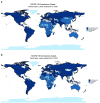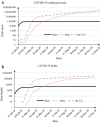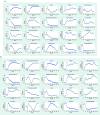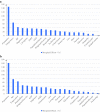The determinants of COVID-19 morbidity and mortality across countries
- PMID: 35393471
- PMCID: PMC8989117
- DOI: 10.1038/s41598-022-09783-9
The determinants of COVID-19 morbidity and mortality across countries
Abstract
We identify 21 predetermined country-level factors that explain marked variations in weekly COVID-19 morbidity and mortality across 91 countries between January and the end of 2020. Besides factors commonly associated with infectious diseases (e.g., population and tourism activities), we discover a list of country characteristics that shape COVID-19 outcomes. Among demographic-geographic factors, the male-to-female ratio, population density, and urbanization aggravate the severity of COVID-19, while education, temperature, and religious diversity mitigate the impact of the pandemic on morbidity and mortality. For the political-legal dimension, democracy and political corruption are aggravating factors. In contrast, female leadership, the strength of legal systems, and public trust in government significantly reduce infections and deaths. In terms of socio-economic aspects, GDP per capita, income inequality, and happiness (i.e., life satisfaction) lead to worse COVID-19 outcomes. Interestingly, technology advancement increases morbidity but reduces mortality. For healthcare factors, SARS (severe acute respiratory syndrome) experience and healthcare infrastructure help countries perform better in combating the pandemic.
© 2022. The Author(s).
Conflict of interest statement
The authors declare no competing interests.
Figures





References
-
- Fama EF, MacBeth JD. Risk, return, and equilibrium: Empirical tests. J. Polit. Econ. 1973;81(3):607–636. doi: 10.1086/260061. - DOI
-
- Nace, T. Population adjusted coronavirus cases: Top 10 countries compared. Forbes (2021). https://www.forbes.com/sites/trevornace/2020/03/22/population-adjusted-c... (Accessed 22 March 2021).
Publication types
MeSH terms
LinkOut - more resources
Full Text Sources
Medical
Miscellaneous

